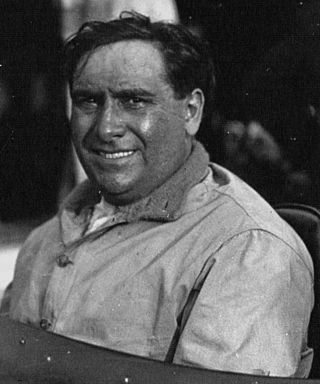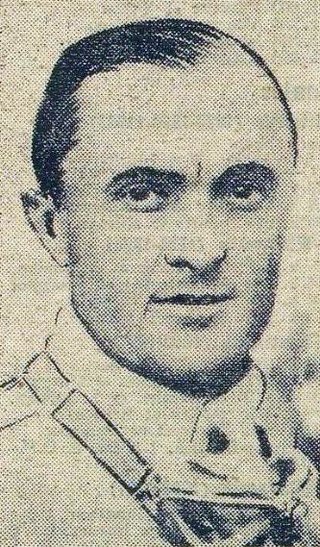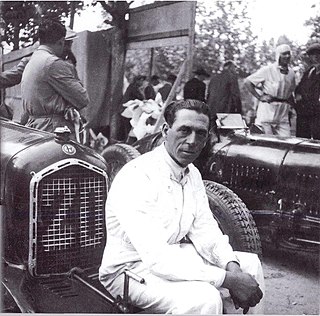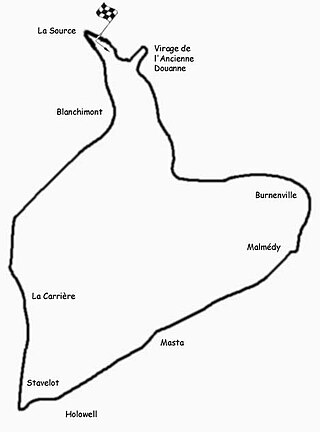| Luigi Arcangeli | |||||||||||
|---|---|---|---|---|---|---|---|---|---|---|---|
 Arcangeli (in front, right), with other Alfa Romeo drivers and Enzo Ferrari behind him. | |||||||||||
| Nationality | | ||||||||||
| Born | 1894 | ||||||||||
| Died | 1931 (aged 28–29) | ||||||||||
| |||||||||||
Luigi Arcangeli (1902 [1] - 23 May 1931) was an Italian motorcycle and car racer.
| Luigi Arcangeli | |||||||||||
|---|---|---|---|---|---|---|---|---|---|---|---|
 Arcangeli (in front, right), with other Alfa Romeo drivers and Enzo Ferrari behind him. | |||||||||||
| Nationality | | ||||||||||
| Born | 1894 | ||||||||||
| Died | 1931 (aged 28–29) | ||||||||||
| |||||||||||
Luigi Arcangeli (1902 [1] - 23 May 1931) was an Italian motorcycle and car racer.
Arcangeli was born at Forlì in 1894. [1]
A factory rider for Sarolea, Sunbeam, Bianchi and Moto Guzzi, he turned to four wheels in the wake of his friend Tazio Nuvolari. His first appearance was a win in 1928 at the Circuito di Senigallia with a 2-litre Bugatti. After Bugatti he drove Talbot-Darracqs, winning at Cremona in 1928, continuing with Maserati Tipo 8C-2500, [2] with a first place at the Rome Grand Prix in 1930. Later he moved to Alfa Romeo and joined Enzo Ferrari's scuderia with Nuvolari as team mate. Arcangeli died the following year at Monza, during the tests for the Italian Grand Prix, while driving an Alfa Romeo Tipo A. [1]
Arcangeli was killed in Monza while driving Alfa Romeo Tipo A. A Scuderia Luigi Arcangeli was created to honor Luigi Arcangeli name. The Scuderia is active nowadays, building ArcangeliMoto regolarità race bikes in limited numbers. [1]

Achille Varzi was an Italian racing driver. He is remembered as the chief rival of Tazio Nuvolari, and was the winner of the 1933 Monaco Grand Prix.

Giuseppe Campari was an Italian opera singer and Grand Prix motor racing driver.

Baconin Borzacchini was an Italian racing driver who often competed under the nom de courseMario Umberto Borzacchini.

The 1936 Grand Prix season was the third year of the 750 kg Formula. The next iteration of the Mercedes-Benz did not prove successful and the team withdrew during the season to instead prepare for the next one. It therefore fell to the resurgent Auto Union team to dominate the racing. In particular, it was their young, new superstar, Bernd Rosemeyer, who mastered the tricky car and who showed superlative skill in wet conditions. Rosemeyer easily won this season's European Championship by winning three of the four Grands Prix.

The Alfa Romeo P3, P3 monoposto or Tipo B was a classic Grand Prix car designed by Vittorio Jano, one of the Alfa Romeo 8C models. The P3 is considered to be the world's first genuine single-seat Grand Prix racing car and was Alfa Romeo's second monoposto after the Tipo A monoposto (1931). It was based on the earlier successful Alfa Romeo P2. Taking lessons learned from that car, Jano went back to the drawing board to design a car that could last longer race distances.

The 1935 Grand Prix season was the second year of the new 750 kg Formula. The success of the previous year encouraged the AIACR to reinitiate the European Championship. It was composed of the seven national Grands Prix and was won by Rudolf Caracciola, driving for the Mercedes-Benz team. The team dominated the season winning five of those Grand Épreuves, as well as four of the other major races of the season. However, in one of the great motor-races in sporting history, Tazio Nuvolari in a Scuderia Ferrari Alfa Romeo beat the combined numbers of the German teams in their home Grand Prix. The season also saw the arrival on the international stage of the bright young talent Bernd Rosemeyer in the Auto Union team.

The 1931 Italian Grand Prix was a Grand Prix motor race held at Monza on 24 May 1931. The race was the first of three Grands Prix that were part of the inaugural European Championship. The Alfa Romeo works team pairing of Giuseppe Campari and Tazio Nuvolari won the race, ahead of their teammates Ferdinando Minoia and Baconin Borzacchini in second, while third place went to the works Bugattis of Albert Divo and Guy Bouriat.

The 1931 Grand Prix season was a watershed year, with the advent of the AIACR European Championship. After several years of Grand Prix racing in the doldrums with little technical development, 1931 saw new models come from all three main manufacturers: Bugatti, Maserati and Alfa Romeo.

The 1932 Grand Prix season marked the second year of the AIACR European Championship. It saw the debut of Alfa Romeo's sensational new Tipo B and with it, Tazio Nuvolari won the Championship driving for the Alfa Corse works team. The 40-year old Nuvolari won two of the three rounds and was second in the other. Still running to a Formula Libre rules for the cars, the regulations were revised to set the races to be between five and ten hours. However, all three national committees ran their races to the minimum time-limit.

The 1933 Grand Prix season was an intermediate year, as it would be the last season for the current AIACR regulations before a new weight-formula was introduced in 1934. As such, the European Championship was not held and the manufacturers held back on further developments of their existing models. Alfa Romeo, following an Italian government financial bailout and like Mercedes-Benz the previous year, had shut down its Alfa Corse works team. Scuderia Ferrari, their regular customer team took up the role of racing Alfa Romeos and a number of ex-works drivers moved across to join their ranks. They were not allowed, however, to buy the impressive Tipo B that had been so dominant in the previous season.
The 1934 Grand Prix season saw the advent of the new 750 kg Formula. In an effort to curb the danger of rising speeds, the AIACR imposed this upper weight limit that effectively outlawed the large capacity engines. The incumbent manufacturers Alfa Romeo, Maserati and Bugatti had been preparing their new models with varying success – the best of which was the Alfa Romeo Tipo B. However, it was the state-sponsored arrival of the two German teams, Mercedes-Benz and Auto Union, and their innovative and progressive cars that ignited a new, exciting era of motor racing.

The Maserati Tipo 26M was a model of Grand Prix race car produced by Italian manufacturer Maserati in Bologna, for a total of 13 units, between 1930 and 1932.

The 1928 Grand Prix season saw the Monegasque driver Louis Chiron, and his Bugatti, take seven Grand Prix victories.

Giovanni “Johnny” Lurani Cernuschi, VIII Count of Calvenzano was an Italian automobile engineer, racing car driver and journalist.
The 1929 Grand Prix season was another interim year, where most races were run to Formula Libre rules due to a lack of regulations from the AIACR that would be popular for race organisers and manufacturers. This blurred the line between racing cars and sports cars with both competing in the same races. Bugatti won the major international races, with their drivers Louis Chiron and "W Williams". The Italian Championship proved very competitive, attracting many top drivers. There it was Alfa Romeo, using their 4-year old P2 model that claimed more victories, than their main competition coming from Bugatti and Maserati.
The 1930 Grand Prix season continued the malaise that had taken over the sport. Although there was little technical advance more privateer teams were forming, getting some factory support. The AIACR continued to mandate its fuel-regulated Formula Libre rules. Across the Atlantic, the AAA abandoned the AIACR regulations. Their new regulations were derisively called the “Junk Formula” by purists, opening up to their own version of Formula Libre: with modified stock-standard cars of up to 366 cu in (6-litres) with two seats.

Pietro Ghersi was an Italian motorcycle racer and, from 1927, also a racecar driver. He was born in Genoa.

The Tunis Grand Prix or Grand Prix de Tunis was a motor race held in the 1920s and 30s in Tunis, the capital of the African colony of the French protectorate of Tunisia.

The 1930 Targa Florio was a non-championship Grand Prix motor race held on 4 May 1930 on the Madonie Medio Course, a 67 mile (108 km) course made up of public roads on the mountainous Italian island of Sicily.

The 1933 Belgian Grand Prix was a Grand Prix motor race held at Spa-Francorchamps on 9 July 1933. The 40-lap race was won by Tazio Nuvolari, of Scuderia Ferrari, driving a Maserati. Second and third were taken by the works Bugatti drivers Achille Varzi and René Dreyfus.